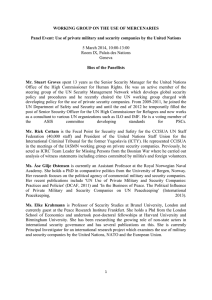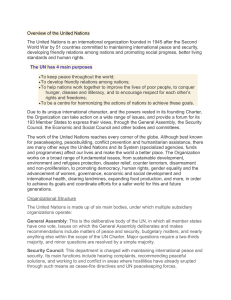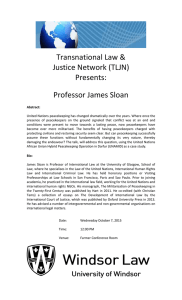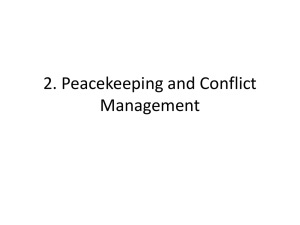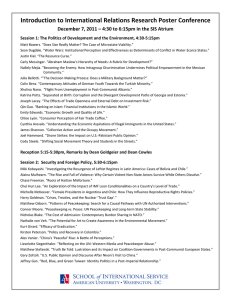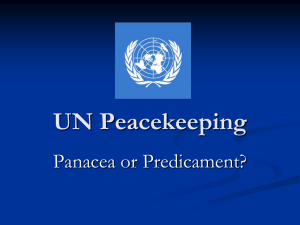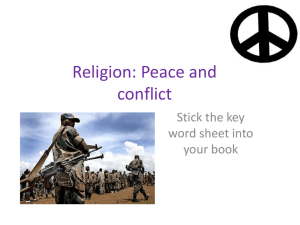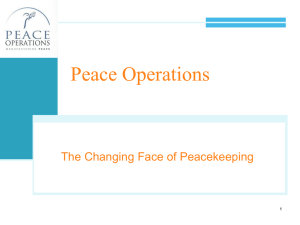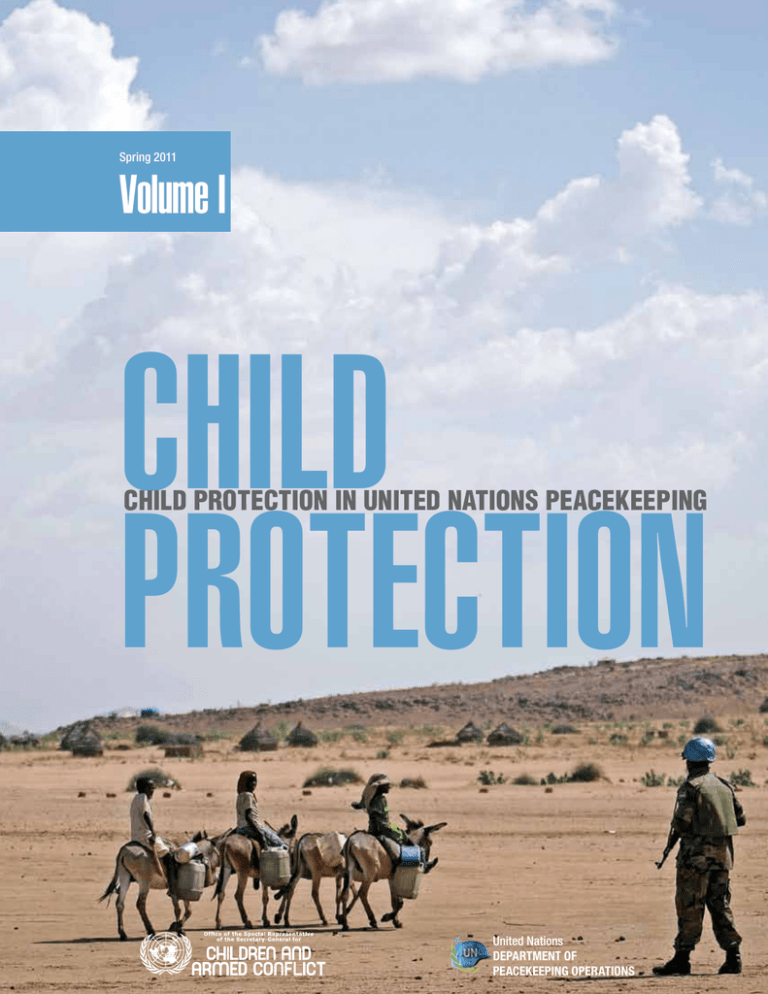
Spring 2011
Volume I
CHILD
PROTECTION
CHILD PROTECTION IN UNITED NATIONS PEACEKEEPING
United Nations
DEPARTMENT OF
PEACEKEEPING OPERATIONS
Cover photo: UN Photo/Stuart Price
Inside photo: UN Photo/Roger Lemoyne
Office of the Special Representative of the Secretary-General for
Children and Armed Conflict
One United Nations Plaza
DC1-627
New York, NY 10017
USA
+1-212-963-3178
http://www.un.org/children/conflict
larose@un.org
gschwend@un.org
Department of Peacekeeping Operations
Child Protection
380 Madison Avenue
19th Floor
New York, NY 10017
USA
http://www.un.org/peacekeeping/issues/children
makome@un.org
bauerm@un.org
© United Nations 2011 All rights reserved
United Nations
DEPARTMENT OF
PEACEKEEPING OPERATIONS
CHILD
PROTECTION
CHILD PROTECTION IN UNITED NATIONS PEACEKEEPING
CONTENTS
Preface
. . . . . . . . . . . . . . . . . . . . . . . . . . . . . . . . . . . . . . . . . . . . . . . . . . . . . . .
5
Foreword
Alain Le Roy . . . . . . . . . . . . . . . . . . . . . . . . . . . . . . . . . . . . . . . . . . . . . .
6
Radhika Coomaraswamy . . . . . . . . . . . . . . . . . . . . . . . . . . . . . . . . . . .
7
Afganistan
Protecting children in security level V . . . . . . . . . . . . . . . . . . . . . . . . .
9
Lebanon
Protecting children on the blue line . . . . . . . . . . . . . . . . . . . . . . . . . . .
11
Sudan
From child soldier to child protection officer . . . . . . . . . . . . . . . . . . .
13
Haiti
Blue beret works for children . . . . . . . . . . . . . . . . . . . . . . . . . . . . . . . .
15
Child protection
Questions and answers . . . . . . . . . . . . . . . . . . . . . . . . . . . . . . . . . . . . .
17
Joint statement
Universal Children’s Day . . . . . . . . . . . . . . . . . . . . . . . . . . . . . . . . . . . .
21
The Sudan: Children during a visit of the Special Representative of the Secretary-General Coomaraswamy to internally displaced
persons camp in Darfur. UN Photo/Olivier Chassot
Acknowledgements
The Department of Peacekeeping Operations and the Office of the Special Representative of the
­Secretary-General for Children and Armed Conflict would like to thank Dee Brillenburg Wurth, Svjetlana
Jovic, Hazel de Wet, James Gatgong, Julie Thériault, and Bernadette Sene for coordinating the storytelling from the missions and for the incredible work and sacrifice of their teams on the ground.
4
VOLUME I
CHILD PROTECTION IN UNITED NATIONS PEACEKEEPING
PREFACE
C
hild Protection in United Nations Peacekeeping: Volume I is the first
in a series illustrating the challenges and successes of protecting
children in some of the most dangerous places on earth. In the
following pages you will learn about the work of Dee, Svjetlana, James
and Julie—peacekeepers and child protection advisers who rely on their
diverse individual experience at home and in the field to introduce the
relatively new concept of child protection to missions in distinct conflict
and post-conflict situations.
The creation of this publication was initiated by Under-Secretary-­
General for Peacekeeping Operations Alain Le Roy and Special Representative of the Secretary-General for Children and Armed Conflict Radhika
Coomaraswamy on the occasion of Universal Children’s Day when the two
United Nations officials reaffirmed their commitment to protect innocent
girls and boys faced with the brutality of war.
We hope that this publication will give you a glimpse into the important
work of our committed peacekeepers.
Thank you,
Timothy La Rose and Muriel Gschwend
Office of the Special Representative of the Secretary-General
for Children and Armed Conflict
Ann Makome and Marianne Bauer
Department of Peacekeeping Operations
Pour les francophones: merci de noter que la version traduite sera disponible ultérieurement. Nous vous prions de nous excuser pour le désagrément.
VOLUME I
CHILD PROTECTION IN UNITED NATIONS PEACEKEEPING
5
Foreword
United Nations
DEPARTMENT OF PEACEKEEPING OPERATIONS
The Department of Peacekeeping Operations has deployed over 120,000 blue
helmets to 15 Peacekeeping Missions all over the world. Each and every one
of those blue helmets has a unique story to tell about working with children
in conflict situations.
Protecting those who are most vulnerable in conflict is one of the crucial
duties the Security Council has entrusted to United Nations Peacekeeping Operations.
Along with our partners, we are called to protect children from all the atrocities they fall
victim to in conflict situations, such as killing, maiming, rape and other forms of sexual
violence, and forced military recruitment.
The Department is committed to ensuring that every peacekeeper is aware of this responsibility, because every peacekeeper can and must contribute to the protection of children
in conflict.
In Child Protection in United Nations Peacekeeping: Volume I you will meet a committed
United Nations police officer in Haiti, a civil affairs officer who serves as child protection
focal point in Lebanon, a child protection adviser in Afghanistan and a child protection
officer in Southern Sudan, who used to be a child soldier himself.
The stories in this publication showcase the commitment of selected individuals. Multiplied
by over 120,000, this commitment—backed by action, however small—can make a significant difference to the children on the ground.
I hope that these stories will inspire every reader to take action to contribute to the
cause.
Alain Le Roy
Under-Secretary-General
for Peacekeeping Operations
6
VOLUME I
CHILD PROTECTION IN UNITED NATIONS PEACEKEEPING
Since 2001, when the first child protection adviser was deployed to the Peacekeeping Mission in Sierra Leone, United Nations peacekeepers have played
an ever growing role in protecting girls and boys in armed conflict. Today,
roughly 75 child protection staff are posted in seven missions led by the
Department of Peacekeeping Operations. These advisers, working directly in
the field, are uniquely placed to advise the mission and especially its leadership on the
needs of children during the transition to peace. They monitor and report child rights violations, negotiate agreements for the release of child soldiers, train staff members, troops
and the police in the protection of children, advocate for the rights of the most vulnerable
and enhance child protection.
Child Protection in United Nations Peacekeeping: Volume I explores the development of child
protection in Afghanistan, Lebanon, Haiti, and the Sudan. Throughout the world, we have
seen tangible achievements as the capacities of child protection grow. Last year alone,
with the assistance of United Nations peacekeepers in the Democratic Republic of the
Congo, armed forces and groups in the country released 1,656 girls and boys from their
ranks. Together with UNICEF, child protection staff in Afghanistan successfully negotiated
an agreement with the Afghan Government to release all children in the national security
forces and to address other violations.
Our colleagues in Peacekeeping are essential to ending such practices as child recruitment,
abduction, sexual violence, and the killing and maiming of girls and boys whose only crime
is that they were born into conflict. The partnership between my Office and the Department
of Peacekeeping Operations along with our field partners such as UNICEF has resulted and
will continue to result in better protection of children.
In the following pages you will spend some time with our dedicated peacekeepers and learn
what they are doing for children.
Radhika Coomaraswamy
Under-Secretary-General
Special Representative of the Secretary-General
for Children and Armed Conflict
VOLUME I
CHILD PROTECTION IN UNITED NATIONS PEACEKEEPING
7
Zero Under 18
Towards Universal
Ratification by 2012
Zero under 18 is the campaign aimed at achieving universal ratification of the Optional Protocol on the Involvement of Children in Armed
Conflict by 2012 in order to establish a moral consensus, that:
•
•
No child should participate in hostilities
No child should be forced to serve in armed forces and armed
groups
•
Every former child soldier will be assisted in starting a new life
free from violence
The campaign was launched by the Office of the Special Representative
of the Secretary-General for Children and Armed Conflict in cooperation with UNICEF and the Office of the High Commissioner for Human
Rights in May 2010.
53 Member States still have to ratify the Optional Protocol before 2012.
Help us spread the word:
http://www.facebook.com/zerounder18
“In Kabul, because of the
extreme security situation,
a prison is the only setting
I have to chat with children.
These interactions always
remind me of what we
are doing and why we are
doing it.” – Dee Brillenburg
Wurth
Afghanistan: Special Representative of the Secretary-General Coomaraswamy speaks to children
participating in a Mine Education Programme in Kabul. Photo credit: Timothy La Rose
Afghanistan:
Protecting children in
security level V
15, he was the youngest detainee and has since finished serv-
In Pol-i-Charkhi Prison in Kabul, a detention center for those
“Children are detained for alleged association with the Tali-
accused of endangering national security, Taliban inmates-
ban, but sometimes only because their uncle or their cousin
played volleyball in the courtyard. As the United Nations
is associated. Some boys are forced to serve in armed groups,
Assistance Mission in Afghanistan (UNAMA) child protection
others join the Afghan National Police. Many are sexually
adviser passed by, on her way to meet juvenile detainees, the
abused by commanders, politicians, and businessmen. We
volleyball players stopped their game to look at the foreign
have to start somewhere to end these h
­orrendous viola-
visitor.
tions,” said Ms. Brillenburg Wurth.
ing his sentence in a juvenile rehabilitation centre in Kabul.
Ali, 17, showed his prosthetic foot. During a raid on an
alleged Taliban group, he and his friends were chased by
pro-Government forces. As he fled, he was shot. He spent six
months in prison in Bagram after his treatment.
In 2009, Dee Brillenburg Wurth and her colleague interviewed
child detainees in the youth ward—all accused of association
with the Taliban—aged 15 to 17. Despite the relatively good
Security challenges
conditions in the prison, the children arrived to the interview
In many Peacekeeping Missions, the Department of Peace­
in shackles, which were quickly removed at the request of the
UNAMA team.
keeping Operations has placed highly skilled child protection
staff who address issues such as child soldiers, sexual exploitation, and child detention. Through local networks, they monitor and report on the situation of children and the information
Children in detention
Mohammed, an Afghan refugee in Pakistan, was working in
collected is incorporated into the Secretary-General’s annual
report to the Security Council on children and armed conflict
and country specific reports to the Council.
a bakery when he was approached by older men and asked if
In Afghanistan, the work is more challenging. “I would like
he wanted to earn $500 carrying narcotics into Afghanistan.
to meet more children,” said Ms. Brillenburg Wurth, who has
What he realized, when he was caught by the border patrol,
served as a child protection advocate in the Sudan, Sierra
was that he was not carrying drugs, but explosives. After
Leone, Burundi, Côte d’Ivoire, Guinea, Sri Lanka, and the
being arrested for allegedly working for the Taliban by the
­Balkans. “In all of these countries,” she continues, “I have
border police, he was handed over to international military
been able to walk in the street with children, hold their hands,
forces and spent five months in Bagram detention facility. At
listen to their stories. In Kabul, because of the extreme secu-
VOLUME I
CHILD PROTECTION IN UNITED NATIONS PEACEKEEPING
9
rity situation, a prison is the only setting I have to chat with
and the international forces are positive and constructive,
children. These interactions always remind me of what we are
the worst violators of children’s rights, like the Taliban, are
doing and why we are doing it. There have been successes.”
unreachable. There is hope, however. On her visit at the
beginning of the year, Ms. Coomaraswamy was able to get
Agreement with the Government
a message to the non-state actors through the High Peace
Ms. Brillenburg Wurth and her counterpart in UNICEF, Ratna
bring these elements to the negotiating table. In February, a
Jhaveri were responsible for negotiating the details of the
notorious militia commander separated seven children from
recent action plan signed by the Government of Afghanistan
his check points in the South. “It’s a start.”
Council—a group set up by Afghan President Hamid Karzai to
and the United Nations on recruitment and use of children.
The signing ceremony this month was witnessed by Special
Representative of the ­
Secretary-General on Children and
Armed Conflict Radhika Coomaraswamy and it aims to release
all children from the Afghan National Security Forces and
enhance the overall protection of children in armed conflict.
“We can’t change things overnight, but with the action plan,
we are planting a seed of change, not only on paper, but in
attitudes. In five years, I hope the general populations will
be as outraged by the situation of children in Afghanistan
as I am. These abuses are against sharia; they are against
national and international law,” said Ms. Brillenburg Wurth.
Reaching the unreachable
Child protection adviser Ms. Dee Brillenburg Wurth and her
UNAMA is arguably one of the most difficult missions for
2011, in order to continue their work to improve the lives of
child protection. While relationships with the Government
girls and boys affected by the conflict.
team of two was expanded to seven staff members in March
Afghanistan: 12-year-old Afghan girl in a nomad camp. Photo credit: Mariam Alimi
UNAMA is arguably one of
the most difficult missions
for child protection.
While relationships with
the Government and the
international forces are
positive and constructive,
the worst violators of
children’s rights are
unreachable.
10
VOLUME I
CHILD PROTECTION IN UNITED NATIONS PEACEKEEPING
“In a traditional mission,
sometimes it can be a
struggle to introduce new
concepts of Peacekeeping
such as child protection,”
- Svjetlana Jovic
Lebanon: Child protection focal point in UNIFIL Svjetlana Jovic with children. Photo credit: Eric Acquaye
Lebanon:
Protecting children
on the blue line
At a school in Southern Lebanon, armed peacekeepers rolled
in her home town of Zagreb. “The war in Croatia transformed
my career; so instead of taking a job in a theatre, I joined
the United Nations,” she said. After working on the UNICEF/
USAID funded project “Unaccompanied Children in Exile” in
Bosnia and Herzegovina, Ms. Jovic served as human rights
officer in Rwanda where she set to reunite children separated
from their parents during genocide. She would later explain
that these assignments were, “my baptism in child protection.”
up in armored personnel carriers. They came to visit school
children, teach them foreign languages, talk about the danger
of mines which prevents them from playing freely outdoors,
discuss hygiene practices and instruct them about road safety
and traffic signs. When a UNIFIL soldier or civilian staff members entered a classroom, the children, who have lived through
conflict, were intimidated. Yet, Peacekeeping has evolved
since the 1978 creation of UNIFIL, with the mandate shifting
from overseeing the Israeli withdrawal from South Lebanon 33
years ago to currently maintaining cessation of the hostilities,
carrying out demining and humanitarian work as well as development projects, among other things. With the appointment of
a child protection focal point, one of the oldest Peacekeeping
Missions in the world starts to change.
Despite Lebanon’s turbulent past, child protection had not
been a priority issue for UNIFIL. Still, the fact that children
A mission adapts
In Lebanon, Jovic faces different challenges. “In a traditional
mission, sometimes it can be a struggle to introduce new
concepts of Peacekeeping such as child protection,” she says.
UNIFIL has no mandate for active child protection activities
such as the monitoring of child rights violations; however,
the mission is doing its best to build in-house knowledge and
understanding of the role of peacekeepers in protecting girls
and boys given the post-conflict environment and its effect
on these children.
One method that Ms. Jovic employs is to organize a series of
workshops on child rights and child protection in partnership
with Save the Children Sweden.
could be victims of violence in Lebanon is of great concern for
the United Nations and Svjetlana Jovic who was appointed as
child protection focal point for UNIFIL in 2008. Her job is to
raise the sensitivity of the mission to the needs of those girls
Becoming advocates
and boys caught amidst the hostilities in this area.
“My idea was to introduce the concept of child protection
No stranger to conflict or Peacekeeping Missions herself, Ms.
national civilians to local personnel by training them. Blue
Jovic had her first contact with United Nations peacekeepers
helmets and berets as well as the local translators and NGO
VOLUME I
CHILD PROTECTION IN UNITED NATIONS PEACEKEEPING
across the mission, to all UN staff - from military and inter-
11
representatives are potential child protection advocates and
Perceptions of the rights of a child vary, as reflected by the
should be used as resources to build child protection capaci-
heated discussion among the 16 participants of the workshop,
ties within UNIFIL but also within their own local commu-
who came from different backgrounds and cultures. Yet all of
nities.” The focus of the training is on national staff since
the attendees were eager to learn. “As a UNIFIL staff member
they are the ones who maintain the institutional memory
working in a Peacekeeping Mission in South Lebanon where
within the field structure where battalions are deployed. They
more than 10,000 troops are deployed amid communities with
accompany military personnel on their daily patrols and can
children, it is an obligation to learn and improve my skills
therefore serve as crucial child rights advocates. Acting at the
on child rights,” UNIFIL Civil Affairs Officer Sarah Al Khoury
forefront of UNIFIL, they are also UNIFIL’s main interlocutors
explains. Reflecting on the training, Monita Youssef, from the
with local communities.
UNIFIL Welfare Office, viewed it as an opportunity “to better
Children face moments where their trust and instincts are put
on trial, especially in conflict situations. The training there-
know the rights of the child according to the human rights
charter and its legal status in Lebanese law.”
fore provides guidance and tools on how to become a credible protector. A key objective of the training is, according to
Sanna Johnson, Save the Children Sweden’s Regional Director,
“to enable UNIFIL’s military and civilian components to better understand why and how children react and respond to
violence. This, in turn, will help peacekeepers formulate their
response.”
The first step down a long road
Ms. Jovic knows that this first training is only the beginning
and she is also keenly aware that there is still a long way to
go. Mainstreaming child protection remains a challenge for
UNIFIL. Still, there is hope that with a better understanding
The eight days of training included briefings and discussions
of the rights of children through training, the mobilization of
on the concept of childhood, the international legal stan-
child advocates in the mission and in the local community,
dards, national legislation, the impact of armed conflict on
Lebanon’s children who have seen so much in their young lives
children, and existing protection measures.
will be better protected.
Lebanon: UNIFIL Finnish soldiers chat with local school children. UN Photo/John Isaac
“Blue helmets and NGO
representatives are
protential child protection
advocates.”
- Svjetlana Jovic
12
VOLUME I
CHILD PROTECTION IN UNITED NATIONS PEACEKEEPING
“Recently, I met one former
child soldier, while visiting
a school to talk about
child rights. The student
stood up in front of his
classmates and teachers
and said, ‘this man helped
me by removing me from
the army when I was very
young.” - James Gatgong
The Sudan: People watch as UNMIS assists in training of Sudanese police officers. UN Photo/Tim McKulka
The Sudan:
From child soldier
to child protection
officer
James Gatgong makes incursions into the field to investigate
reported incidents of grave violations against children. He
trains commanders, Southern Sudanese police officers, Government officials and community leaders. “I love to work for
children, especially when it involves promoting their rights.”
Restoring peace in
Southern Sudan
The SPLA began transforming into a conventional army in
2006 and integrated a number of different armed groups
within its ranks. Despite the many improvements, there are
still high illiteracy rates among the soldiers and limited
knowledge and understanding of the rights of children. In
his current role as child protection officer with the United
Nations Mission in the Sudan (UNMIS), James Gatgong is,
among many other assignments, responsible for training the
United Nations Peacekeeping forces and soldiers in Southern
Sudan on international and national child protection law.
James has a special connection with child soldiers in the
The children in the Sudan also need to be made aware
Sudan. He used to be one.
of their rights which is why Gatong speaks to students.
At 13, James was forced by his brother, who was then a vil-
“Recently, I met one former child soldier, while visiting a
lage chief in Boor Mayendit County Unity State, to join the
Sudan People’s Liberation Army (SPLA). “There was heavy
pressure on local communities to join the SPLA in fighting
school to talk about child rights. The student stood up in
front of his classmates and teachers and said, ‘this man
helped me by removing me from the army when I was very
the enemy,” he said.
young.’ The boy told the class that he intends to work for
Mr. Gatgong recalls joining the SPLA with War Child author and
can give my own people. He will be too,” said Mr. Gatgong.
internationally acclaimed rapper Emmanuel Jal who comes
children of Southern Sudan. I am proud of the help that I
from the same village. In 1987, Mr. Gatgong and thousands of
other children trekked on foot down the long and treacherous
route to Ethiopia. Many died of hunger and disease along the
way. Upon arrival they became part of the Red Army which
Child Protection Unit
consisted mostly of children. He recalls being ordered to fight
The UNMIS Child Protection Unit has 25 national and inter-
the war in the Equatoria region of Southern Sudan. “In 1993,
national staff who hail from all over the globe. Several of the
I saw many children killed during the war. This is one of my
international staff bring conflict-specific expertise, while
most painful memories. I was seriously wounded and evacu-
the Sudanese officers provide knowledge of their country’s
ated to Kenya by the Red Cross,” he said. Once in Kenya, he
incredibly diverse history, culture, languages and religions.
resumed school, where he studied social work.
What ties them all together is their dedication and com-
VOLUME I
CHILD PROTECTION IN UNITED NATIONS PEACEKEEPING
13
mitment to ensuring peace for the children of the Sudan.
Their common goal is: to secure full implementation of com-
Agreement with the SPLA
mitments made by the parties to conflict related to child
At least than 1,500 children have left military barracks since
protection.
the Comprehensive Peace Agreement between the North and
Following the referendum in early 2011, UNMIS child protec-
the South was signed, but still many remain.
tion staff called on all parties to remember the progress
To date, a total of 210 boys associated with the SPLA have
made for children in Southern Sudan. UNMIS child protection
been verified, registered, officially demobilized and reunified
advisers, along with UNICEF have worked hard to put in place
with their families since the signing of the action plan wit-
comprehensive legislation protecting children including the
nessed by Special Representative Radhika Coomaraswamy. The
criminalization of child recruitment. Decisions that the
SPLA leadership through the Office of the Director of Moral
parties to the Comprehensive Peace Agreement are taking
Orientation and SPLA Child Protection Unit is currently seeking
should build on these foundations and further strengthen
ways to hold accountable those SPLA persons involved in the
the protective environment for children.
recruitment and use of children in the army.
Moving forward, they will continue to focus on training and
In this constantly evolving environment, UNMIS staff, along
sensitizing communities and Government officials on the
with other protection actors, continue to adapt to the child
existence of these rights; more than 5,000 SPLA troops have
protection needs of this complex country and to do their best
been introduced to child rights issues through awareness cam-
to ensure that any changes in the political landscape will not
paigns disseminated via UNMIS Radio Miraya and in-person.
roll back the recent gains for the children of the Sudan.
The Sudan: Children in the town of Labado where roughly 60,000 of the town's inhabitants had fled from violence and attacks.
UN Photo/Evan Schneider
The UNMIS child protection
unit has 25 national and
international staff who hail
from all over the globe.
14
VOLUME I
CHILD PROTECTION IN UNITED NATIONS PEACEKEEPING
“It is my duty to protect
children from being sold
and trafficked across the
border.” - Julie Thériault
Haiti: The Under-Secretary-General for Peacekeeping Operations meets school children. UN Photo/Marco Dormino
Haiti:
Blue beret works for
children
Sexual violence and trafficking in children
In Haiti, armed elements sexually abuse girls and boys with
impunity. Documenting these grave violations is therefore
essential for bringing perpetrators to justice. Apart from
monitoring sexual violence, Officer Thériault has visited
many hospitals to ensure that sexually abused children are
“Since the terrible earthquake, Haiti’s children are clearly
getting adequate treatment. The current situation is particu-
more vulnerable to abuse than before,” says Police ­Officer
larly precarious as earthquake survivors and infected people
Julie Thériault of the United Nations Stabilization Mission
are also in desperate need of care. “I was shocked to see that
in Haiti (MINUSTAH). The earthquake that struck Haiti in
medical equipment is rare and that basic medicines and sup-
January 2010 destroyed families, schools, churches, and
plies such as rape kits are lacking,“ she says.
conventional security environments. Officer Thériault, from
Canada, went to Haiti recently to join the United Nations
Police Brigade for the Protection of Minors.
Another concern is the trafficking in children. “Many orphanages have sprouted up in the time after the earthquake in
Haiti. It is my duty to check the legality of these institu-
“Never have my 18 years of experience as a police officer in
tions and to protect children from being sold and trafficked
Canada been more requested than in today’s Haiti, where
across the border,” Officer Thériault says. During the past
the post-earthquake shock still persists in the backbones
few months, she has reported several illegal orphanages.
of Haitian people, armed elements roam through the ruins
and there are no zones of peace for the most innocent and
vulnerable,” Officer Thériault describes.
Children in detention
Ms. Thériault is responsible for mentoring and training the
Haitian police and for monitoring and reporting on child
Frequently, children charged with criminal activities are kept
rights violations including sexual violence, abduction, traf-
in detention conditions that do not meet the juvenile stan-
ficking in children, and the association of children with
dards established by international consensus. “I visit many
armed elements. This information is vital for the Security
prisons to make sure that children and adults do not share
Council and the Office of the Special Representative for Chil-
the same cells and that minimum standards of detention are
dren and Armed Conflict at United Nations Headquarters of
in place. However, often, boys and girls are stuffed into very
the Secretary-General who follow these developments as a
small cells, without a bed, without toilets, and without suf-
matter of peace and security.
ficient food,” the peacekeeper says. Any shortcomings are
VOLUME I
CHILD PROTECTION IN UNITED NATIONS PEACEKEEPING
15
reported to the MINUSTAH child protection team and to the
off the chains of colonialism and the desire of Haiti to stand
Corrections Unit for follow-up.
on its own feet has always been strong. For MINUSTAH, it has
therefore become even more pressing to build strong national
capacities.
Building Haitian police capacities
When asked what her most unforgettable moment was, Thériault paused and replied, ”I have visited many regions in this
In an effort to create a more secure environment for the chil-
country, in all those regions the common denominator is the
dren of Haiti, one of Officer Thériault’s key responsibilities is
children. Those children and other people I have met have pro-
to rebuild the capacities of the national police, which have
vided me with memories that I will cherish my whole life. Their
been seriously impaired by the earthquake. She works with
hugs, the look in their eyes, and their smiles will forever be
the national police on a daily basis, conducts joint patrols and
engrained in my memory along with the hope that a better
mentors them. Haiti was the first Caribbean country to throw
Haiti will be built by helping one person, one child at a time.”
Haiti: Officer Thériault meeting children during a patrol in Haiti.
UN Photo / MINUSTAH
Frequently, children
charged with criminal
activities are kept in
detention conditions that
do not meet the
juvenile standards
established by international
consensus.
16
VOLUME I
CHILD PROTECTION IN UNITED NATIONS PEACEKEEPING
Everyone in a Peacekeeping
Mission has a role to play
in protecting
children from the
effects of war.
Somalia: Child in an internally displaced persons camp in Basasso. Photo credit: Timothy La Rose
Questions and
answers
Who in Peacekeeping Operations is responsible
for protecting children?
Everyone in a Peacekeeping Mission has a role to play in protecting children from the effects of war—from the blue helmet and the United Nations police to the international and
Why is child protection
a new concept in
United Nations Peacekeeping?
In the early days of Peacekeeping, over 60 years ago, the
idea was simple: the United Nations would stand between
warring States and monitor peace agreements, including
national civilian staff member.
To ensure that mainstreaming takes place within the missions,
child protection advisers are deployed.
What is the role and key function of child
protection advisers in UN Peacekeeping?
cease fires. However, as conflicts changed, our missions
Child protection advisers routinely perform the following
had to evolve as well. New aspects such as peacebuilding,
tasks:
human rights monitoring, demobilization and disarmament,
and child protection were introduced into Peacekeeping.
•
making child protection an integral part of the mis-
The missions have become multidimensional. Child protec-
sion’s engagement including in peace processes and in
tion specifically was introduced through Security Council
the planning, strategies and the activities of all the
resolution 1261 in 1999.
Conflicts disproportionately affect children. Many are subject
to abductions, rape, military recruitment, killing, maiming,
mission components.
•
Training of newly-deployed peacekeepers on child protection. Approximately 60 per cent of trainees are mili-
and other forms of exploitation, and are deprived of their basic
tary personnel, 30 per cent United Nations police and
rights to education, especially when schools are attacked.
10 per cent civilian staff. This training complements
the training on child protection every peacekeeper must
Helping children breaks the cycle of violence that can occur
receive prior to his or her deployment.
when children—who have known violence throughout their
lives—become adults. Peacekeepers, through their child
Mainstreaming and advising mission leadership on
•
Monitoring and reporting grave child rights viola-
protection advisers, are now able to cover issues such as
tions: The Security Council established a mechanism to
the release of child soldiers, juvenile justice, and the reform
monitor and report on the most serious violations that
of relevant legislation.
are committed against children in conflict. This mecha-
VOLUME I
CHILD PROTECTION IN UNITED NATIONS PEACEKEEPING
17
nism referred to as the 1612 monitoring and reporting
Apart from these, actions of child protection advisers and the
mechanism (MRM), after the Security Council resolution,
mission will vary along with mission mandates.
reports on six grave violations: the killing or maiming,
recruiting or use of child soldiers, attacks against schools
or hospitals, rape or other grave sexual violence, abduction, and denial of humanitarian access for children.
Peacekeeping Missions through their child protection
advisers and other capacities with monitoring mandates (e.g. human rights teams and military observers)
contribute to the collection and verification of infor-
Where do child protection advisers
operate today?
Child protection advisers currently work in the following missions led by the Department of Peacekeeping Operations:
mation related to the six grave violations. The MRM
UNMIS (Sudan), UNAMID (Sudan), MONUSCO (Democratic
reports that are thereby compiled - with UNICEF and
Republic of the Congo), MINUSTAH (Haiti), UNAMA (Afghani-
other partners – are critical, as they are the basis of
stan), UNMIL (Liberia), and UNOCI (Côte d’Ivoire).
action of the United Nations Security Council Working
•
Group on Children and Armed Conflict and could ulti-
Since 2001, the Department of Peacekeeping Operations has
mately result in sanctions.
deployed child protection advisers in Sierra Leone, Burundi,
Establishing dialogue with parties to conflict: Child
protection advisers play a key role in establishing
Chad, the Democratic Republic of the Congo, Afghanistan, Côte
d’Ivoire, Liberia, Haiti and the Sudan.
dialogue with perpetrators and in developing action
plans to end grave violations committed against children, in particular the recruitment of child soldiers,
killing and maiming, and sexual violence.
Action plans and more informal negotiations led to the
•
How do Peacekeeping Operations fit in the big
picture of child protection in the United Nations?
following numbers of child soldiers released in 2010:
“The protection of children must be central to the humani-
1656 in the Democratic Republic of the Congo, 210 in
tarian, peacemaking and Peacekeeping policies of the
Southern Sudan, 574 in Darfur.
United Nations, and should be given priority within exist-
Advocating: The child protection adviser acts as an
ing human rights and humanitarian procedures.”
advocate, facilitator, and an adviser to the mission
Graça Machel report Impact of armed conflict on children
leadership on pertinent child protection issues.
A/51/306
Haiti: MINUSTAH military personnel assists hurricane victims. UN Photo/Marco Dormino
Many children are subject
to abductions, rape,
military recruitment,
killing, maiming, and other
forms of exploitation,
and deprived of their
basic rights to education,
especially when schools
are attacked.
18
VOLUME I
CHILD PROTECTION IN UNITED NATIONS PEACEKEEPING
Deployment of child protection advisers
Peacekeeping Mission with child protection adviser
Peacekeeping Mission without child protection adviser
The work of the Department of Peacekeeping Operations is
peace agreements. In 2009, the Department of Peacekeep-
complementary to other actors in child protection. Coopera-
ing Operations and the Department of Field Support issued
tion with them is critical to provide a comprehensive response.
a child protection policy, that has also been adopted by the
The child protection function within Peacekeeping does not
implement programmes for the local government. This inde-
Department of Political Affairs for political and peacebuilding
missions.
pendence gives missions a certain leeway to spearhead highly
All these documents govern the work of Peacekeeping Mis-
political and sensitive activities on the ground.
sions in protecting children:
Security Council Resolutions: 1261 (1999), 1314 (2000), 1379
(2001), 1460 (2003), 1539 (2004), 1612 (2005), and 1882 (2009)
Which documents govern the work of child
protection in United Nations Peacekeeping
Operations?
Policy: DPKO/DFS Policy on mainstreaming the protection,
rights and well-being of children affected by armed conflict
within UN Peacekeeping Operations (2009)
Since 1999, the Security Council has issued seven resolutions on children and armed conflict. Each of these resolu-
For further information please contact:
tions assigns specific roles to the Department of Peacekeeping
Ann Makome (makome@un.org) or
Operations in the area of child protection.
Marianne Bauer (bauerm@un.org)
In addition, since 2001, specific provisions on child protec-
Department of Peacekeeping Operations—Child Protection
tion have been included in 13 Peacekeeping mandates and
http://www.un.org/peacekeeping/issues/children
VOLUME I
CHILD PROTECTION IN UNITED NATIONS PEACEKEEPING
19
The Sudan: Special Representative of the Secretary-General Coomaraswamy on her mission to the Sudan to witness the signing of an action plan with the SPLA.
UN Photo/Olivier Chassot
Joint statement
Myanmar, Nepal, the Occupied Palestinian Territory and
Israel, Somalia, the Sudan, and all other places in conflict
and we reaffirm our commitment to be their voices and pro-
New York, 19 November 2010
tectors.
Tomorrow, 20 November, is Universal Children’s Day, a day to
In 1996, Graça Machel, an international advocate for the
celebrate youth and to demonstrate our universal belief that
childhood is sacred for all girls and boys. Millions of children
around the world, however, are denied a safe home and community, a functioning school and a protected playground.
Growing up in conflict, their innocence is stolen when they
are abducted from schools, recruited to fight, wounded or
killed, separated from their families and emotionally as well
rights of children, reported for the first time on the nightmares that these children experience. Since then, we have
come a long way as the protection of children in armed conflict has been firmly secured as part of the international peace
and security agenda. Through the systematic monitoring and
naming of child rights violators by the ­Secretary‑General, the
United Nations is acting as one and has secured the demobili-
as physically scarred for life.
zation of thousands of children associated with armed forces
We remember the needs of the children in Afghanistan,
the Security Council expressed its readiness to impose sanc-
Burundi, the Central African Republic, Chad, Côte d’Ivoire,
tions against those persistently listed as violating the rights
the Democratic Republic of the Congo, Haiti, Iraq, Lebanon,
of the innocent.
and groups over the past 10 years. Moreover, in June 2010,
Haiti: Under-Secretary-General Le Roy visits the area around a border bridge between the Dominican Republic and Haiti. UN Photo/Marco Dormino
We will use the synergies of our two offices,
along with UNICEF and all United Nations
partners to secure the dream of childhood
everywhere.
20
VOLUME I
CHILD PROTECTION IN UNITED NATIONS PEACEKEEPING
Joint statement on the occasion of
Universal Children’s Day by Special
Representative of the Secretary-General
Radhika Coomaraswamy and
Under-Secretary-General Alain Le Roy.
Over the past decade, we have continually strengthened the
groups in the country freed over 1,000 girls and boys from
partnership between our two offices as the role of child protec-
their ranks. The United Nations Mission in Sudan (UNMIS) and
tion in Peacekeeping developed. In 2001, the first child pro-
UNICEF facilitated the demobilization of over 200 children and
tection adviser was deployed to the mission in Sierra Leone.
the African Union-United Nations Hybrid Operation in Darfur
Nearly 10 years later, child protection advisers and focal points
(UNAMID) played an important role in the release of close to
are posted in nine missions led by the Department of Peace-
1,000 children over the last year. In Afghanistan, Myanmar and
keeping Operations, where they negotiate the release of chil-
the Democratic Republic of the Congo, three agreements for
dren and ensure that United Nations blue helmets are sen-
the release of child fighters are currently being prepared.
sitized to the vulnerabilities of war-affected children. Today,
While we celebrate these achievements, Universal Children’s
every single peacekeeper receives training on child protection
Day also reminds us that we still have to address many more
and hence serves as the eyes and ears of the Office for Children
challenges that children face during conflict. As long as
and Armed Conflict in the field. In a joint effort by our offices,
schools become targets of attacks and children once freed
UNICEF and other United Nations partners, we have achieved
are re-recruited or abused in the absence of the rule of law,
notable success in protecting children affected by conflict. In
we pledge to carry on this important work. We will use the
2010 alone, with the assistance of United Nations peacekeep-
synergies of our two offices, along with UNICEF and all United
ers from the United Nations Organization Stabilization Mission
Nations partners to secure the dream of childhood every-
in the Democratic Republic of the Congo, armed forces and
where, even in the darkest corners of conflict.
VOLUME I
CHILD PROTECTION IN UNITED NATIONS PEACEKEEPING
21
Join the conversation on
peacekeeping and child protection
Twitter
http://www.twitter.com/childreninwar
http://www.twitter.com/unpeacekeeping
Facebook
http://www.facebook.com/zerounder18
http://www.facebook.com/unpeacekeeping
Flickr
http://www.flickr.com/photos/childrenandarmedconflict
http://www.flickr.com/unpeacekeeping
Youtube
http://www.youtube.com/childreninwar
Websites
http://www.un.org/children/conflict
http://www.un.org/peacekeeping
http://www.un.org/peacekeeping/issues/children
22
VOLUME I
CHILD PROTECTION IN UNITED NATIONS PEACEKEEPING
United Nations
DEPARTMENT OF
PEACEKEEPING OPERATIONS
http://www.un.org/children/conflict
http://www.un.org/peacekeeping/issues/children

